Amami
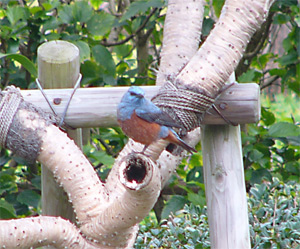
Blue Rock-thrush
On the morning of 12th February 2005 we had our only smooth ride through an airport for an internal flight because Peter had kindly bought the tickets in advance. We flew to Amami and spent a while looking for birds around the entrance to the airport as Armas was off finding a vehicle for us. We found a Dusky Thrush, a Nauman's Thrush and a Brown Thrush on a lawn and had good close views of a male Blue Rock-thrush. I also enjoyed seeing and listening to a singing Japanese White-eye. Armas arrived and again we were in a less-than-ideal car but Armas had said the hire place had no vans. We drove past the hire place and it had quite a few vans parked there. Maybe they were all booked. Who knows?
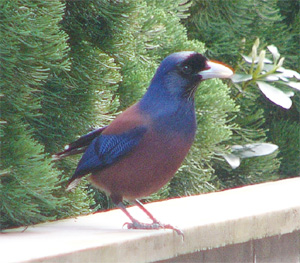
Lidth's Jay
The drive to our hotel in Naze gave us 8 Grey-faced Buzzards, usually on telegraph poles and a very brief view of a Lidth's Jay, which we stopped for but it had gone. Somewhere between the airport and Naze, in a town, we spotted another Lidth's Jay. We stopped and spent a great half hour or so watching a pair of these birds going to and from a nest hole in a tree and showing exceptionally well. This species is more normally associated with woodland and we did see a few in Amami's woods but the views were terrible. We were lucky to have found this pair. Also here were three Whistling Green Pigeons (Treron sieboldii – scientific name added because this bird seems to have lots of common names!).
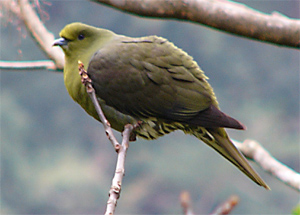
Whistling Green Pigeon
In Naze we stopped at the hotel and Armas went in. We milled about for a bit until Armas came out and said we were going to another hotel, which we duly drove to. We unloaded at this hotel and checked in but were soon heading out again, aiming for Amami Virgin Forest at Kinsakubaru. We walked down a track surrounded by thick woodland including exotic-looking tree ferns. The woods were quiet but we did come across one mixed flock that comprised Japanese White-eyes, Japanese Pygmy Woodpecker, Varied and Great Tits, Japanese Bush Warbler, Brown-eared Bulbul and a pair of Ruyuku Minivets, endemic to the Ruyuku Islands and a target species. We also found a couple of Phylloscopus warblers that we couldn't immediately identify. After getting the salient characteristics of these birds we concluded we had found Ijima's Willow Warbler, a bird that breeds only on the Izu islands of Japan and who's wintering areas are pretty much unknown. We eventually saw a few of these birds during our stay on Amami so believe that Amami is at least one wintering site. We also found another Whistling Green Pigeon in a tree and saw at least ten Pale Thrushes on the track. We had another target bird that Armas said he had heard tapping. We carefully searched the area and found the owstoni race of White-backed Woodpecker. A potential split we believe. It certainly didn't look like a White-backed Woodpecker although it did behave and sound like one. A little further up the track we found another, which gave better views than the first although it was pretty well unphotographable. Finally, as we were at the car ready to leave, we heard a distant Japanese Black Woodpigeon.
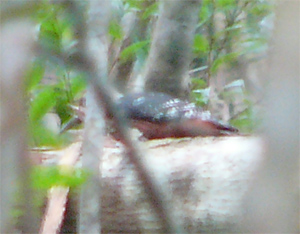
Record shot of owstoni White-backed Woodpecker
We weren't done yet as we had to drive to Mount Yarno and look for Amami Woodcock after the sun had set. We were there before sunset and so walked around the area. As dusk arrived we heard both Northern Boobook (split from Brown Wood-owl) and Ruyuku Scops-owl. We also found Yellow-throated and Black-faced Bunting. We spent the next few hours driving around the roads of this mountain watching for woodcock on the muddy slopes. We had one woodcock species briefly shoot in front of us but that was it.
Next morning we set off at 5.30 to again walk through the woods of Amami Virgin Forest looking for Amami Thrush. We had two possible sightings. Possible because White's Thrush winters here as well. It was otherwise quiet with only 12 Pale Thrushes and a Japanese Wild Boar.
The next site was Amami Natural Forest, where it was raining a lot and very wet. The woods seemed very quiet and we did a short circuit returning to the information centre. Armas went into the centre but we decided to carry on walking round looking for our next target species. We were brought to an abrupt halt when a loud and melodious song suddenly pierced the silence. We scanned about and a couple of us lucked on brief views of our target bird: Ruyuku Robin, a startlingly beautiful bird and a real skulker! We waited about an hour for it to reappear and although we heard it singing a few times we could not relocate it. We headed back towards the info centre coming across another mixed flock of the usual suspects: Japanese White-eyes, Great and Varied Tits, Japanese Bush Warbler and Japanese Pygmy Woodpecker. Near the info centre is a playground for children, empty today because of the rain. Here we were lucky. Red-flanked Bluetail plus a male Ruyuku Robin in the open, at least for a while. Eventually, after much effort, we all had excellent views of the bird. I tried photographing it but it didn't like to stay still and my camera does not like to focus in dark, wet woodland!
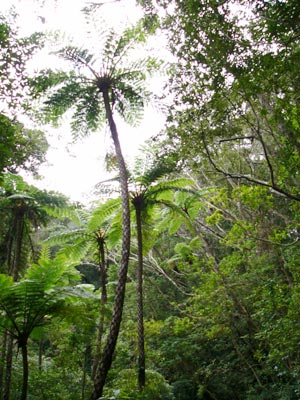
Amami Tree-ferns
That night we were back out looking for woodcock. We finally scared one up from the road in front of us. It has a very strange fluttering flight, quite unlike Eurasian Woodcock, and settled in long grass. I got a brief view of the head in the car headlights and saw the bare patch behind the eye - a definite Amami Woodcock. Now for the owls. Finding owls is best done using a torch and a tape of the bird's song. We had a torch, with almost powerless batteries but no tapes, despite having been told earlier in the tour by Armas that he did have tapes. Armas's 'technique' is to drive along with full beam headlights on and hope to spot the birds as they sit on branches above the road. Apparently this always works and he has had 50+ Scop's owls. We got a couple of brief flight views, only because one of us was lucky enough to be looking in the right direction at the right time. We never did see a scop's-owl sitting. We did stop suddenly when one, then another birds flew from a branch above the car. These were clearly large white thrushes and we believe they were Amami Thrushes rather than White's, although the views could have been better.
Next morning we (minus leader who was recovering in bed) were back in Amami Virgin Forest, again hunting for Amami Thrush. No luck, just the usual species including a Ruyuku Scops-owl seen as it flushed. Then we had to fly to Okinawa. At the hotel Armas left us to go sort out flights. He came back and tried to convince us that the phrase 'all internal flights included' did not include the flight from Amami to Okinawa. We disagreed and eventually he paid for the tickets. We asked him whether we could pick up the rental vehicle when we landed on Okinawa and head immediately to the north of the island so we could start early next morning. He agreed. On arrival at Okinawa we were left for one and a half hours and on his return Armas said he'd got a local hotel. However, there was good news. Tomorrow we would have an eight-seater van, so there would be plenty of room for all of us plus luggage.
